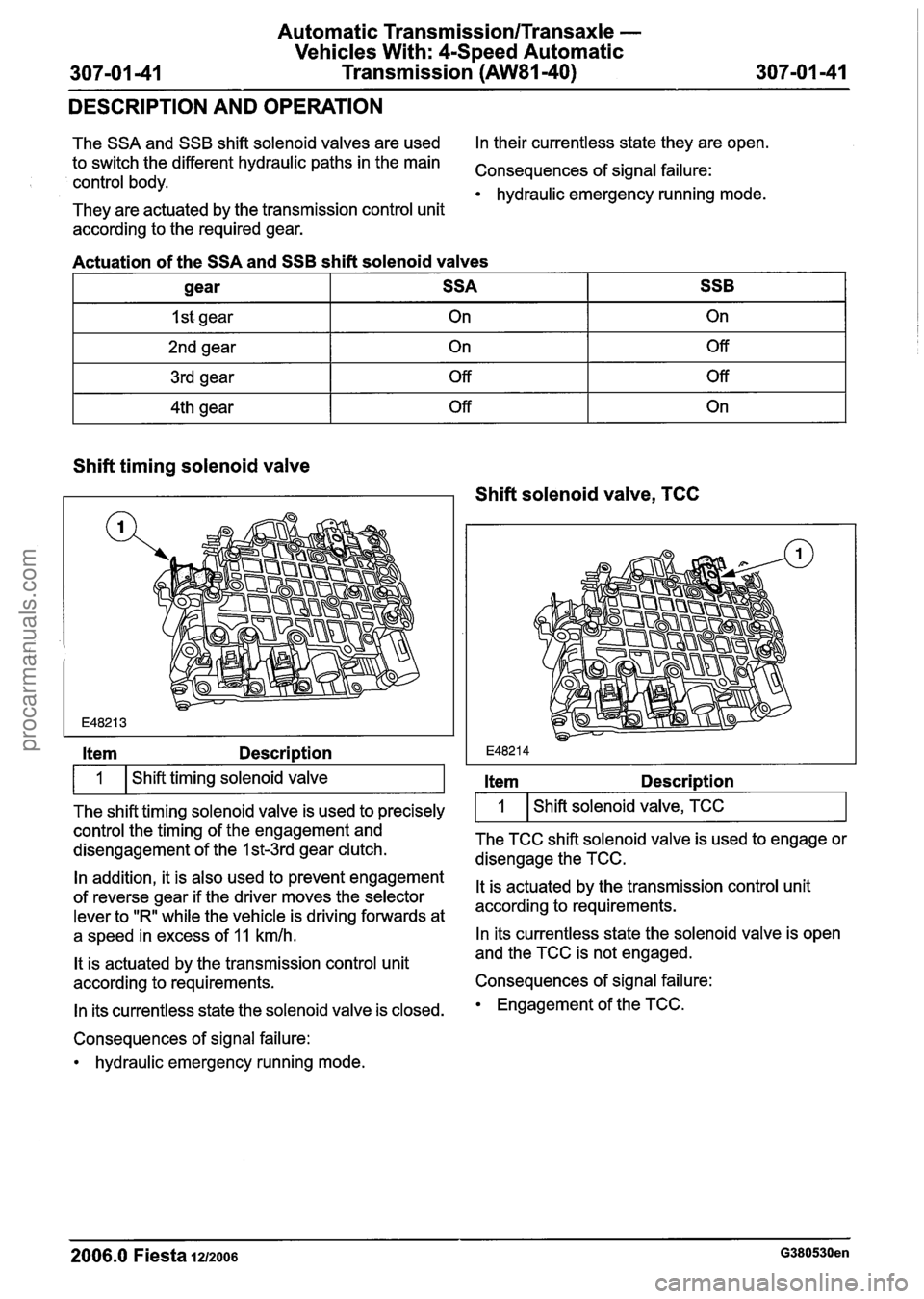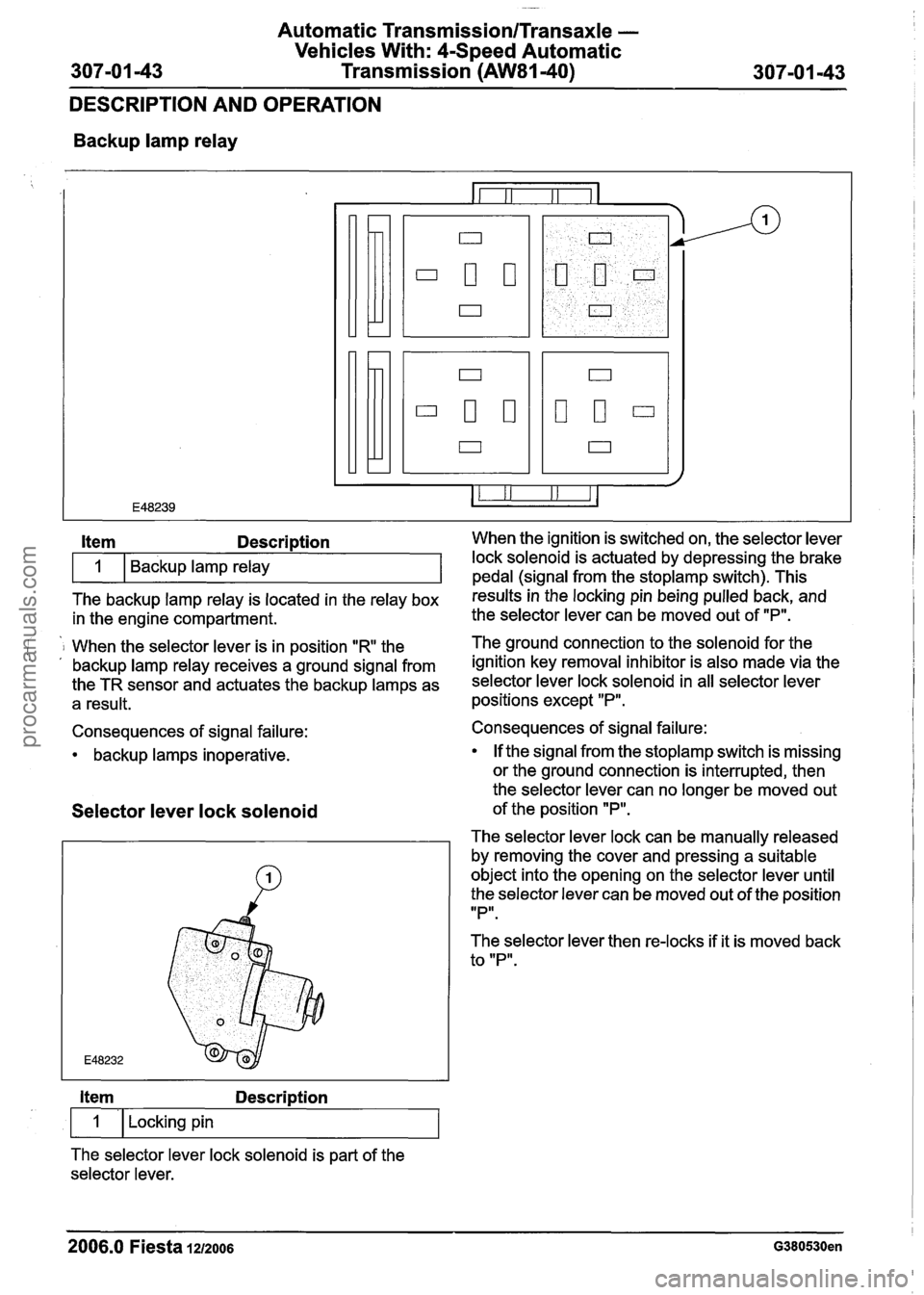Page 996 of 1226

Automatic Transmission/Transaxle -
Vehicles With: 4-Speed Automatic
307-01 -36 Transmission (AW81-40) 307-01 -36
DESCRIPTION AND OPERATION
Actuation of the MIL warning lamp Warning tone request
The information required to actuate the
MIL The
driver's door is open.
warning lamp is sent the transmission control The instrument cluster passes on the warning tone unit to the instrument cluster.
request to the GEM. The GEM generates the
warning tone.
I I I
Actuation of the overdrive indicator lamp
I
The overdrive indicator lamp is located on the
instrument panel.
The MIL warning lamp
is actuated by the The transmission control unit sends
a warning tone
instrument cluster if there are serious faults in the request
to the instrument cluster if the following
transmission control or if the transmission fluid conditions are
met:
temperature is excessively high.
The selector lever is not in position "P",
The information required to actuate the overdrive
indicator lamp is sent from the transmission control
unit when the overdrive switch on the selector lever
is pressed.
2006.0 Fiesta 1u2oos G380530en
procarmanuals.com
Page 997 of 1226

Automatic TransmissionlTransaxle -
Vehicles With: 4-Speed Automatic
307-01 -37 Transmission
(AW81-40) 307-01 -37
DESCRIPTION AND OPERATION
Sensors
OSS sensor
TSS sensor
The TSS sensor is an inductive pickup.
It measures the transmission input speed via the
outer plate carrier of the
3rdl4th gear clutch and
sends the signal to the transmission control unit.
The transmission control unit uses this signal for:
Torque reduction during gearshifts,
Pressure control during gearshifts,
Shift timing adaptation during upshifts,
Shift timing adaptation during shifts from 3rd to
4th gear,
Shift timing adaptation during shifts from 4th to
3rd gear,
Avoidance of gearshift judder during
engagement of a transmission range,
Torque reduction when pulling away.
Consequences of signal failure:
No TCC,
no torque reduction,
no shift timing adaptation,
no 4th gear. The
OSS sensor is a Hall sensor.
It is mechanically connected via a gear to the input
wheel of the differential assembly.
It measures the vehicle speed via the input wheel
of the differential assembly and sends the signal
to the transmission control unit.
The transmission control unit uses this signal for:
Gearshift control,
Engagement of the TCC,
Torque reduction during gearshifts,
Pressure control during gearshifts,
Shift timing adaptation during upshifts,
Shift timing adaptation during shifts from 3rd to
4th gear,
Shift timing adaptation during shifts from 4th to
3rd gear,
Reverse gear safety strategy,
Avoidance of gearshift judder during
engagement of a transmission range,
Torque reduction when pulling away,
Hill climb mode,
Hill descent mode.
2006.0 Fiesta 1212006 G380530en
procarmanuals.com
Page 998 of 1226

Automatic Transmission/Transaxle -
Vehicles With: 4Speed Automatic
307-01 -38 Transmission (AW81-40) 307-01 -38
DESCRIPTION AND OPERATION
Consequences of signal failure:
NoTCC,
no torque reduction, no shift timing adaptation,
no 4th
gear.
TR sensor
The TR sensor serves to signal the currently
selected transmission range to the transmission
control unit.
It is a switch which transmits the selected
transmission range directly to the transmission
control unit.
In addition, the starter inhibit relay is actuated by
the PCM via the TR sensor when the selector lever
is in the positions "P" or
N.
In selector lever position "R the backup lamp relay
is also actuated via the TR sensor.
The transmission control unit uses this signal for:
Controlling the main line pressure,
Gearshift control,
Engagement of the TCC,
Shift timing adaptation during upshifts,
Shift timing adaptation during shifts from 3rd to
4th gear,
Shift timing adaptation during shifts from 4th to
3rd gear,
Reverse gear safety strategy,
Avoidance of gearshift judder during
engagement of a transmission range,
Torque reduction when pulling away.
Consequences of signal failure:
NoTCC,
no shift timing adaptation.
2006.0 Fiesta 1212006 G380530en
procarmanuals.com
Page 999 of 1226

Automatic Transmission/Transaxle -
Vehicles With: 4-Speed Automatic
307-01 -39 Transmission (AW81-40) 307-01 -39
DESCRIPTION AND OPERATION
TFT sensor Overdrive switch
The TFT sensor is located in the oil pan on the
main control body and is part of the transmission
wiring harness.
It measures the current transmission fluid
temperature and sends the signal to the
transmission control unit.
The transmission control unit uses this signal for:
Cold start mode,
Engagement of the TCC,
Shift timing adaptation during upshifts,
' , Shift timing adaptation during shifts from 3rd to
4th gear,
Shift timing adaptation during shifts from 4th to
3rd gear,
Overheating protection mode.
Consequences of signal failure:
NoTCC,
no shift timing adaptation,
no 4th gear. The overdrive switch
is located on the selector
lever.
It allows the driver to suppress or enable gearshifts
into 4th gear when
"D" is selected.
The signal from the overdrive switch is transmitted
to the transmission control unit.
When gearshifts into 4th gear are suppressed, the
transmission control unit sends a corresponding
signal via the CAN
databus to the instrument
cluster. The instrument cluster then actuates the
overdrive indicator lamp.
Consequences of signal failure:
no suppression of gearshifts into 4th gear.
2006.0 Fiesta 1212006 G380530en
procarmanuals.com
Page 1000 of 1226

Automatic Transmission/Transaxle -
Vehicles With: 4-Speed Automatic
307-01 -40 Transmission (AW81-40)
307-01 -40
DESCRIPTION AND
OPEMION
Driver's side door ajar switch
The door ajar switch is located in the door lock on
the driver's side.
When the door is closed a ground connection is
signalled to the transmission control unit.
When the door is opened this ground connection
is interrupted.
The transmission control unit uses the signal from
the driver's side door ajar switch to warn the driver
if the selector lever is not in position
"P" and the
driver's door is open.
In this case the transmission control unit transmits
the warning tone request via the CAN
databus to
the instrument cluster.
The instrument cluster passes this request on to
the GEM, which then generates a warning tone.
Consequences of signal failure:
no warning tone request.
Actuators
Main regulating valve
Item Description
I 1 I Main regulating valve I
The main regulating valve is a proportional valve
which converts the applied electric current into a
proportional hydraulic pressure.
The currentless state corresponds to maximum
pressure.
/
The main regulating valve is used to determine the
main line pressure and therefore the actuating
pressure for the clutches and brakes.
Consequences of signal failure:
hydraulic emergency running mode.
SSA and SSB shift solenoid valves
Item Description
2006.0 Fiesta 1212006 G380530en
1
2
SSA
SSB
(- t..
procarmanuals.com
Page 1001 of 1226

Automatic Transmission/Transaxle -
Vehicles With: 4-Speed Automatic
307-01
-41 Transmission (AW81-40) 307-01 -41
DESCRIPTION AND OPERATION
The SSA and SSB shift solenoid valves are used In
their currentless state they are open.
to switch the different hydraulic paths in the main
Consequences of signal failure: control body. hydraulic emergency running mode.
They are actuated by the transmission control unit
according to the required gear.
Actuation of the SSA and SSB shift solenoid valves
Shift timing solenoid valve
gear
I st gear
2nd gear
3rd gear
4th gear
kern Descri~tion
I 1 I Shift timing solenoid valve I
SSA On
On Off
Off
The shift timing solenoid valve is used to precisely SSB
On Off
Off
On
control the timing of the engagement and
disengagement of the
I st3rd gear clutch.
In addition, it is also used to prevent engagement
of reverse gear if the driver moves the selector
lever to "R" while the vehicle is driving forwards at
a speed in excess of
11 kmlh.
It is actuated by the transmission control unit
according to requirements.
In its currentless state the solenoid valve is closed.
Consequences of signal failure: hydraulic emergency running mode.
Shift solenoid valve, TCC
Item Description
I 1 I Shift solenoid valve, TCC I
The TCC shift solenoid valve is used to engage or
disengage the TCC.
It is actuated by the transmission control unit
according to requirements.
In its currentless state the solenoid valve is open
and the TCC is not engaged.
Consequences of signal failure:
Engagement of the TCC.
2006.0 Fiesta 1212006 G380530en
procarmanuals.com
Page 1002 of 1226
Automatic Transmission/Transaxle -
Vehicles With: 4-Speed Automatic
Transmission
(AW81-40)
DESCRIPTION AND OPERATION
Starter inhibit relay
2006.0 Fiesta
12/2006 G380530en
Item Description The starter inhibit relay is located in the central
1 Starter inhibit relay junction
box (CJB).
In the selector lever positions "P" and "Nu a ground N0TE:The engine cannot be started if the electrical signal is directed from the PCM via the TR sensor connector is disconnected from the TR sensor.
to the starter inhibit relay, as a result of which the
starter inhibit relay is actuated.
procarmanuals.com
Page 1003 of 1226

Automatic Transmission/Transaxle -
Vehicles With: 4-Speed Automatic
307-01 -43 Transmission (AW81-40) 307-01 -43
DESCRIPTION AND OPERATION
Backup lamp relay
The backup lamp relay is located in the relay box results inthe locking pin being pulled back, and
in the engine compartment. the
selector lever can be moved out of "P".
Item Description When the ignition is switched on, the selector lever
i 1 When the selector lever is in position "R the The ground connection to the solenoid for
the . , backup lamp relay receives a ground signal from ignition key removal inhibitor is also made via the
the TR sensor and actuates the backup lamps as selector lever lock solenoid in all selector lever
a result. positions except "P".
1
Consequences of signal failure:
backup lamps inoperative. Backup lamp relay
Selector
lever lock solenoid
lock solenoid is actuated by depressing the brake
pedal (sianal from the stoplamp switch). This
Item Description
1 I Locking pin
The selector lever lock solenoid is part of the
selector lever. Consequences of signal failure:
If the signal from the
stoplamp switch is missing
or the ground connection is interrupted, then
the selector lever can no longer be moved out
of the position
"P".
The selector lever lock can be manually released
by removing the cover and pressing a suitable
object into the opening on the selector lever until
the selector lever can be moved out of the position
IIPlr.
The selector lever then re-locks if it is moved back
to "P".
2006.0 Fiesta 1212006 G380530en
procarmanuals.com